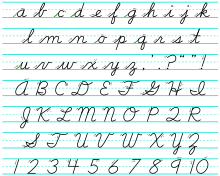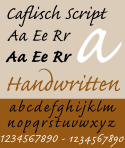Script typeface


Script typefaces are based upon the varied and often fluid stroke created by handwriting. They are organized into highly regular formal types similar to cursive writing and looser, more casual scripts.
Formal scripts
A majority of formal scripts are based upon the letterforms of seventeenth and eighteenth century writing-masters like George Bickham, George Shelley and George Snell. The letters in their original form are generated by a quill or metal nib of a pen. Both are able to create fine and thick strokes. Typefaces based upon their style of writing appear late in the eighteenth century and early nineteenth century. Contemporary revivals of formal script faces can be seen in Kuenstler Script and Matthew Carter's typeface Snell Roundhand. These typefaces are frequently used for invitations and diplomas to effect an elevated and elegant feeling.
Casual scripts
Casual scripts show a less formal, more active hand. The strokes may vary in width but often appear to have been created by wet brush rather than a pen nib. They appear in the early twentieth century and with the advent of photocomposition in the early-1950s their number rapidly increased. They were popularly used in advertising in Europe and North America into the 1970s. Examples of casual script types include Brush Script, Kaufmann and Mistral.
Both types of typefaces have evolved rapidly in the second half of the 20th century. Historically, most lettering on logos, displays, shop frontages did not use fonts but was rather custom-designed by signpainters and engravers, so many emulate the styles of hand-drawn signs from different historical periods. As phototypesetting and business needs and then computers have made printing text at a range of sizes far easier than in the metal type period, it has become increasingly common for businesses to use type for logos and signs rather than hand-drawn lettering. Script typefaces have also evolved rapidly in the last twenty years with the release of the OpenType format, which most fonts are now released in. This allows characters that match one another to be inserted into a document automatically, so fonts can convincingly mimic handwriting without the user having to choose the correct substitute characters manually.[1]
Unicode
In Unicode there is a script Latin alphabet for mathematical use, with both capital and small letters. Few fonts provide support for all 52 characters, and their presentations vary in style from roundhand to chancery hand and others. 𝒜ℬ𝒞𝒟ℰℱ𝒢ℋℐ𝒥𝒦ℒℳ𝒩𝒪𝒫𝒬ℛ𝒮𝒯𝒰𝒱𝒲𝒳𝒴𝒵 𝒶𝒷𝒸𝒹ℯ𝒻ℊ𝒽𝒾𝒿𝓀𝓁𝓂𝓃ℴ𝓅𝓆𝓇𝓈𝓉𝓊𝓋𝓌𝓍𝓎𝓏
See also
References
- ↑ Shaw, Paul. "Lettercentric: Type as Writing". Print. Retrieved 21 September 2015.
- Blackwell, Lewis. 20th Century Type. Yale University Press: 2004. ISBN 0-300-10073-6.
- Fiedl, Frederich, Nicholas Ott and Bernard Stein. Typography: An Encyclopedic Survey of Type Design and Techniques Through History. Black Dog & Leventhal: 1998. ISBN 1-57912-023-7.
- Thi Truong, Mai-Linh; Siebert, Jürgen; Spiekermann, Erik. FontBook: Digital Typeface Compendium., FSI FontShop International: 2006, ISBN 978-3-930023-04-2
- Macmillan, Neil. An A–Z of Type Designers. Yale University Press: 2006. ISBN 0-300-11151-7.
External links
- Columbia University online facsimile of writing manuals including The Universal Penman
- Allan Haley article on using digital versions of script typefaces